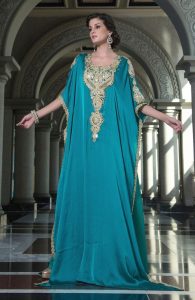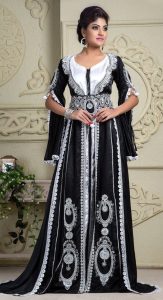The vast and diverse region of Arabia boasts a rich cultural heritage reflected in its traditional clothing. From the flowing thobes of the desert to the vibrant kaftans of the cities, Arabic dress embodies both practicality and elegance. What is traditional Arabic dresses? Let’s delve into this colorful world and explore some of the most prominent garments.
The Thobe: A Timeless Classic
The thobe, also known as dishdasha, is a long, loose-fitting robe worn by men throughout the Arab world. Traditionally crafted from lightweight, breathable materials like cotton or linen, the thobe is designed for comfort in hot climates.
Variations by Region:
Thobe styles can vary depending on the region. In the Arabian Peninsula, thobes are typically ankle-length and white. Countries like Morocco may feature hooded thobes or thobes with intricate embroidery.
Simple Yet Sophisticated:
The thobe’s elegance lies in its simplicity. The lack of buttons or collars creates clean lines, and the flowing fabric allows for ease of movement. It can be dressed up or down with accessories like belts or head coverings.
The Abaya: A Symbol of Modesty
The abaya is a long, flowing cloak worn by women across the Arab world. It serves as a symbol of modesty and religious devotion. Similar to the thobe,abayas are typically made from lightweight fabrics to ensure comfort in warm weather.
-
Regional Flair: Like the thobe, abaya styles differ by region. In the Gulf countries, abayas are often black, while other regions may feature a wider variety of colors. Some abayas are adorned with embroidery or embellishments.
-
Modern Interpretations: The modern abaya has evolved to encompass a wider range of styles. Modern abayas come in various colors, fabrics, and cuts, allowing women to express their personal style while maintaining modesty.
The Kaftan: A Versatile Staple
The kaftan is a versatile garment worn by both men and women in the Arab world. It’s a loose-fitting tunic that can be long or short-sleeved and reach ankle or knee length. Kaftans are known for their vibrant colors, intricate embroidery, and rich fabrics.
-
A Celebration of Culture: Kaftans are often worn for special occasions like weddings, festivals, and religious holidays. The vibrant colors and patterns represent joy and celebration.
-
Comfort and Style: The kaftan’s loose fit provides comfort and allows for freedom of movement. The rich fabrics and decorative elements add a touch of luxury and sophistication.
Beyond the Garment: Accessories and Adornment
Traditional Arabic dresses extend beyond the main garments. Here are some accessories that complement the look:
-
Headcoverings: Men traditionally wear head coverings like shemaghs or kufis. Women may wear headscarves (hijabs) or other coverings depending on local customs and religious beliefs.
-
Jewelry: Bold and intricate jewelry is a common element in Arabic attire. Women may adorn themselves with necklaces, bracelets, earrings, and anklets. Men might wear rings or cufflinks.
-
Footwear: Traditional footwear in Arab countries can include leather sandals or boots for men and flats or slippers for women.
These accessories add a personal touch and cultural significance to traditional Arabic attire.
Traditional Arabic dress offers a fascinating glimpse into the region’s culture and heritage. From the practical thobe to the celebratory kaftan, each garment reflects the values and aesthetics of its place of origin. As the world continues to connect, appreciating the beauty and diversity of traditional Arabic dress allows for a deeper understanding and appreciation of different cultures.

Materials and Design for Hot Climates
Traditional Arabic dresses have adapted to the region’s hot and dry climate. Let’s explore some key features:
-
Lightweight Fabrics: Natural fabrics like cotton and linen are popular choices. They allow air to circulate and keep the wearer cool.
-
Loose Fits: Flowing silhouettes that don’t cling to the body promote air circulation and provide a comfortable range of motion.
-
Head Coverings: Head coverings like shemaghs and headscarves protect the head and face from the sun.
These design elements all contribute to making traditional Arabic clothing practical for the hot climate.
Cultural Significance and Modernity
Traditional Arabic dress holds cultural significance throughout the region.
-
Symbolism: Clothing can signify social status, religious beliefs, or regional identity. For example, the color and style of head coverings can vary by location and custom.
-
Modern Adaptations: Modern designers incorporate traditional elements into contemporary fashion. This keeps the cultural heritage alive while reflecting modern sensibilities.
Today, traditional dress is often worn for cultural celebrations, religious holidays, and formal occasions. It’s also a source of inspiration for modern fashion designers around the world.

Colors and Regional Flair
Traditional Arabic dresses come in a vibrant array of colors and styles, each reflecting the unique cultural heritage of different regions.
-
Subtlety and Symbolism: In some regions, particularly in the Arabian Peninsula, thobes and abayas are typically white or neutral tones. This reflects the desert environment and can also hold symbolic meaning related to purity or piety.
-
A Celebration of Color: Other regions embrace a wider color palette. brightly colored kaftans are popular choices for festive occasions, reflecting a celebratory mood. Colors can also hold symbolic meaning, with red symbolizing joy or good luck in some cultures.
-
Embroidery and embellishments: Detailed embroidery or other embellishments can add a touch of luxury and individuality to garments. These decorative elements often feature geometric patterns, calligraphy, or even natural motifs. The specific techniques and designs used can vary by region, showcasing the rich craftsmanship traditions of different areas.
Local Flair: As you explore the vast region of Arabia, you’ll discover that beautiful dress reflects the local way of life and customs. This adds to the richness and variety of Arabic clothing.

Beyond Clothing: Cultural Expression
Traditional Arabic dress is more than just clothing; it’s a form of cultural expression. Let’s explore some of the ways it reflects the region’s heritage:
-
Social Status and Identity: In some communities, clothing choices can indicate social status, marital status, or even tribal affiliation.
-
Religious Significance: Religious beliefs can influence clothing choices. For example, the headscarf (hijab) worn by many Muslim women represents modesty and piety.
Understanding these cultural contexts adds depth to our appreciation of dress. It’s not just about fashion; it’s about the stories the clothing tells about the people who wear it.


